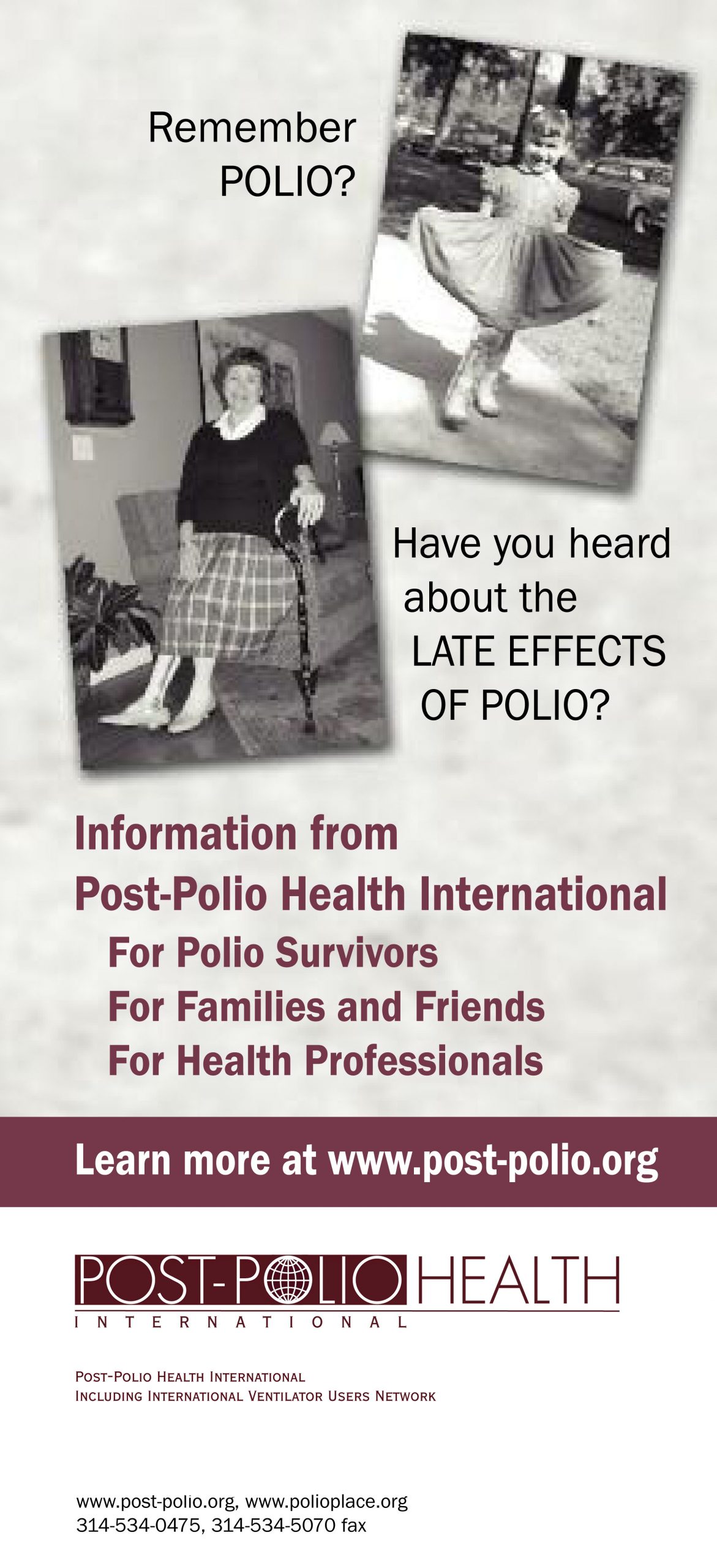Read this in English | Chinese (PDF) | Farsi (PDF) | French | German | Italian | Spanish
For Polio Survivors
Do you know that there are 11-15 million other individuals who had polio living in the world today?
Although some people think "polio does not exist anymore," even now the poliovirus is causing poliomyelitis in under-vaccinated children. You may live in a country that is still trying to eradicate the poliovirus and where there are barriers to education, employment and healthcare for survivors. Or, you may live where cases of acute polio no longer occur, but where you have to challenge the status quo that excludes people with disabilities from full participation in life. In either case, for you, polio still exists.
There are long-term physical consequences to having had poliomyelitis.
New symptoms recognized by the medical community that may relate to prior polio include:
- unaccustomed fatigue – either rapid muscle tiring or feeling of total body exhaustion;
- new weakness in muscles, both those originally affected and those seemingly unaffected;
- pain in muscles and/or joints;
- sleeping problems;
- breathing or swallowing problems;
- and/or decreased ability to tolerate cold temperatures.
Any combination of the symptoms may affect your ability to conduct customary daily activities such as climbing stairs, walking, lifting, etc.
Recommended Actions
For Families
and Friends
For more information for caregivers, family and friends of polio survivors, see PHI's Post-Polio Health Care Considerations for Families & Friends.

Poliomyelitis is caused by any of three serotypes of poliovirus.
The major illness types include non-paralytic and paralytic poliomyelitis. The poliovirus damages motor nerve cells and, consequently, the muscles instructed by those nerves are temporarily or permanently paralyzed. Acute polio does not infect sensory nerves, so sensation is not affected. Paralytic poliomyelitis can be classified as spinal, bulbar or spino-bulbar. Bulbar is the most serious form of polio and involves the part of the brain dealing with the vital functions of respiration and swallowing.
The new problems facing your loved one are not caused primarily by the poliovirus, but are problems secondary to having polio.
Polio survivors experiencing new symptoms have not been re-infected nor are they contagious. They need your understanding and support.
Recommended Actions
Polio survivors do not experience new problems in isolation. What affects them can affect you.
You will be addressing, possibly for the first time, many issues:
- selecting specialized health professionals and new equipment;
- learning about access and disability laws;
- making choices in how to spend time, energy, and financial resources.
Additionally, long-standing roles made by necessity may be challenged or changed.
Understanding and accepting all of the ramifications of the late effects of polio is not easy. No one can predict the future, but it is recommended that you and the polio survivor in your life attempt to approach the concerns as a team that includes health professionals.
Polio survivors can have feelings of guilt about being "a burden." Or, they may feel sadness for "the way things were." You may feel resentful of your new responsibilities. It is recommended that you address these issues as they arise. Everyone has different skills, methods and preferences in solving problems. Ascertaining and utilizing these skills can be very beneficial to maintaining a healthy relationship. Many relationships have benefited from an association with a support or self-help group or from family counseling.
Educating yourself about the many facets of the late effects of polio is the first step in determining your role in a management plan grounded in the commitment of your loved one to make lifestyle changes.
For Health Professionals
Some patients may describe these symptoms and "forget" to tell you they had polio. This triad of symptoms is typically presented at least fifteen years after the acute case of poliomyelitis, as the North American, Western European and Australasian experience documents. Individuals, now in their seventh or eighth decade, are facing a combination of new polio problems and aging. Because poliomyelitis has not yet been eradicated from the world, survivors will be seeking assistance for years to come.
As early as 1875, Raymond and Charcot described a polio patient who reported new weakness and atrophy in his right arm – the arm he used excessively due to residual weakness in his left arm. As survivors from the 1950s epidemics sought medical assistance for "tiring more easily," researchers explored these new complaints and, over the years, have developed the following criteria for post-polio syndrome:*
- Prior paralytic poliomyelitis with evidence of motor neuron loss, as confirmed by history of acute paralytic illness, signs of residual weakness and atrophy of muscles on neurologic examination, and signs of denervation on electromyography (EMG).
- A period of partial or complete functional recovery after acute paralytic poliomyelitis, followed by an interval (usually 15 years or more) of stable neurologic function.
- Gradual or sudden onset of progressive and persistent new muscle weakness or abnormal muscle fatiguability(decreased endurance), with or without generalized fatigue, muscle atrophy, or muscle and joint pain. (Sudden onset may follow a period of inactivity, or trauma or surgery.)
- Less commonly, symptoms attributed to post-polio syndrome include new problems with breathing or swallowing.
- Symptoms persist for at least a year.
- Exclusion of other neurologic, medical, and orthopedic problems as causes of the symptoms.
It is important to note that there are consequences to having had polio that may not fit the criteria. Polio survivors who visit your office may be reporting a variety of neurologic, orthopedic, medical, musculoskeletal, emotional and rehabilitation complaints, all of which need to be methodically addressed and not dismissed simply as signs of aging.
Post-Polio Health International recommends that all polio survivors receive consistent, basic medical evaluations. If a patient's symptoms are not explained and alleviated by general medical approaches and the symptoms persist or worsen, a referral is in order. A physiatrist or neurologist can conduct a neuromuscular evaluation to establish a diagnosis and to recommend a management plan that will be sent to you and your patient.

Have you heard about the LATE EFFECTS of Polio?
This introduction to information about the late effects of polio, is available as a printed, 4-part brochure written for three audiences: polio survivors, their families and friends, and health professionals. The sections can be separated and passed along to others.
First copy is free!
Additional copies:
25 brochures for $10
Postage not included.
General Reading
Koopman FS, Beelen A, Gilhus NE, de Visser M, Nollet F. Treatment for postpolio syndrome. Cochrane Database of Systematic Reviews 2015, Issue 5.
Maynard, F.M., & Headley, J.L. (Eds.) (1999). Handbook on the Late Effects of Poliomyelitis for Physicians and Survivors. Saint Louis, MO: Gazette International Networking Institute (now Post-Polio Health International). (www.post-polio.org).
*March of Dimes Birth Defects Foundation. (1999). Identifying Best Practices in Diagnosis & Care. Warm Springs, GA: March of Dimes International Conference on Post-Polio Syndrome. (www.modimes.org)
Headley, J.L., Maynard, F.M., Machell, S.T., Wise, H.H. (2011). Post-Polio Health Care Considerations for Families & Friends. Saint Louis, MO: Post-Polio Health International.
